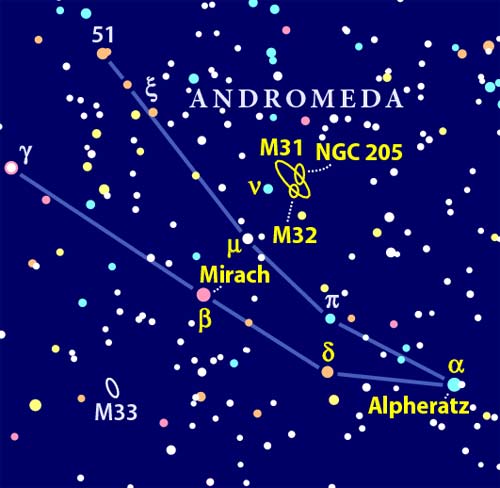That episode probably introduced more people to the Andromeda Galaxy (also know as M31) and its vast distance from Earth — 2.5 million light-years — than all of the books and articles written about it.
The idea that it would take a super-charged Enterprise 3 centuries to get there points to intergalactic space’s enormity. Yet tonight, with just our eyes and clear conditions, we can watch this galaxy approach the sky’s zenith (the point in the sky directly overhead). Light-polluted skies might hide M31 from naked-eye view, but carefully aimed binoculars can still spot it.
From Alpheratz, slide about one binocular field northeast, to the faint star Delta (δ) Andromedae, and then another field farther northeast to Mirach.
Take a sharp right turn northwestward, first stopping at Mu (μ) Andromedae and then onward to Nu (ν) Andromedae.
Finally, look just northwest of Nu for a dim, elongated blur. It may not look like much at first, but you’ve found the Andromeda Galaxy, the combined light of several hundred billion suns. That starlight traveled for more than 2 million years just to reach your eyes tonight!
The Andromeda Galaxy is the closest major galaxy to our Milky Way and the brightest visible from the Northern Hemisphere. Binoculars show it as a broad, oval smudge of grayish light highlighted by a prominent core. How much of the galaxy your binoculars will show depends on sky clarity and darkness. Only its bright central nucleus can pierce severe light pollution. From a dark, rural location, you can see the full span of the extensive spiral-arm disk. M31 reaches out as far as 5° — that’s as wide as 10 Full Moons stacked end to end!
Had Captain Kirk and company continued on their intergalactic trek, they would have noticed Andromeda’s galactic groupies. You can spot M31’s two largest satellite galaxies through binoculars, although each will push your limits. The smaller and brighter of the pair, M32, can be spotted as a starlike light patch due south of M31’s central core. The second companion, NGC 205 is larger, fainter, and more difficult to observe. Look for it to the north of M31’s core, about twice as far as M32. Both are classic examples of dwarf elliptical galaxies. M32 looks almost circular, while NGC 205 is more oblate.
M31 is a real treat through binoculars, but let us consider this as we gaze contemplatively toward this distant island universe: A civilization like the Kelvans might be staring back at us through their own binoculars, wondering if you and I exist.
The Andromeda Galaxy may be the brightest, but it is certainly not the only galaxy visible in tonight’s sky. Be sure to stop by Astronomy.com this month for a list of others that await you. Then, join me here next month, as we move northward to Perseus, the mythological hero who rescued the princess Andromeda from the jaws of death. Till then, remember that two eyes are better than one.










